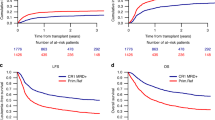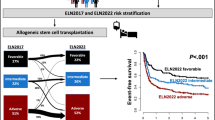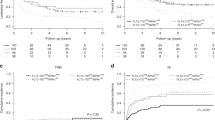Abstract
The monitoring of the minimal residual disease by Wilms' tumor 1 expression (MRDWT1) is a standardized test, which can be used in over 80% of patients with AML. To investigate the prognostic value of MRDWT1 in patients undergoing allogeneic stem cell transplantation (allo-SCT) for AML, MRDWT1 was monitored 3 months after transplantation in 139 patients. MRDWT1 positivity did not lead to any therapeutic intervention. Median follow-up was 39.3 (6.4–99.8) months. Patients with positive MRDWT1 at 3 months experienced more often post-transplant relapse (27/30, 90%) than those with negative MRDWT1 (16/109, 14.7%) (P<0.0001). Similarly, a shorter 3-year event-free survival (EFS) was observed in MRDWT1-positive patients (10% vs 72.3% in MRDWT1-negative patients, P<0.0001). The correlation between relapse and MRDWT1 was stronger in blood than in bone marrow samples. Multivariate analysis confirmed the detrimental role of 3-month positive MRDWT1 for relapse (hazard ratio (HR): 15.42; 95% confidence interval (CI): 7.53–31.59; P<0.0001) and EFS (HR: 10.71; 95% CI: 5.41–21.21; P<0.0001). Interestingly, 3-month chimerism was less predictive of relapse than positive MRDWT1. In conclusion, our results demonstrate the usefulness of peripheral blood MRDWT1 monitoring in identifying very high-risk patients, who could benefit from an early preemptive treatment, and those who do not need such an intervention.
This is a preview of subscription content, access via your institution
Access options
Subscribe to this journal
Receive 12 print issues and online access
$259.00 per year
only $21.58 per issue
Buy this article
- Purchase on Springer Link
- Instant access to full article PDF
Prices may be subject to local taxes which are calculated during checkout



Similar content being viewed by others
References
Pallisgaard N, Hokland P, Riishøj DC, Pedersen B, Jørgensen P . Multiplex reverse transcription-polymerase chain reaction for simultaneous screening of 29 translocations and chromosomal aberrations in acute leukemia. Blood 1998; 92: 574–588.
Döhner H, Estey EH, Amadori S, Appelbaum FR, Büchner T, Burnett AK et al. Diagnosis and management of acute myeloid leukemia in adults: recommendations from an international expert panel, on behalf of the European LeukemiaNet. Blood 2010; 115: 453–474.
Cilloni D, Saglio G . WT1 as a universal marker for minimal residual disease detection and quantification in myeloid leukemias and in myelodysplastic syndrome. Acta Haematol 2004; 112: 79–84.
Østergaard M, Olesen LH, Hasle H, Kjeldsen E, Hokland P . WT1 gene expression: an excellent tool for monitoring minimal residual disease in 70% of acute myeloid leukaemia patients—results from a single-centre study. Br J Haematol 2004; 125: 590–600.
Cilloni D, Renneville A, Hermitte F, Hills RK, Daly S, Jovanovic JV et al. Real-time quantitative polymerase chain reaction detection of minimal residual disease by standardized WT1 assay to enhance risk stratification in acute myeloid leukemia: a European LeukemiaNet study. J Clin Oncol Off J Am Soc Clin Oncol 2009; 27: 5195–5201.
Yang L, Han Y, Suarez Saiz F, Saurez Saiz F, Minden MD . A tumor suppressor and oncogene: the WT1 story. Leukemia 2007; 21: 868–876.
Ogawa H, Tamaki H, Ikegame K, Soma T, Kawakami M, Tsuboi A et al. The usefulness of monitoring WT1 gene transcripts for the prediction and management of relapse following allogeneic stem cell transplantation in acute type leukemia. Blood 2003; 101: 1698–1704.
Lange T, Hubmann M, Burkhardt R, Franke G-N, Cross M, Scholz M et al. Monitoring of WT1 expression in PB and CD34(+) donor chimerism of BM predicts early relapse in AML and MDS patients after hematopoietic cell transplantation with reduced-intensity conditioning. Leukemia 2011; 25: 498–505.
Kwon M, Martínez-Laperche C, Infante M, Carretero F, Balsalobre P, Serrano D et al. Evaluation of minimal residual disease by real-time quantitative PCR of Wilms’ tumor 1 expression in patients with acute myelogenous leukemia after allogeneic stem cell transplantation: correlation with flow cytometry and chimerism. Biol Blood Marrow Transplant 2012; 18: 1235–1242.
Zhao X-S, Jin S, Zhu H-H, Xu L-P, Liu D-H, Chen H et al. Wilms’ tumor gene 1 expression: an independent acute leukemia prognostic indicator following allogeneic hematopoietic SCT. Bone Marrow Transplant 2012; 47: 499–507.
Pozzi S, Geroldi S, Tedone E, Luchetti S, Grasso R, Colombo N et al. Leukaemia relapse after allogeneic transplants for acute myeloid leukaemia: predictive role of WT1 expression. Br J Haematol 2013; 160: 503–509.
Rossi G, Carella AM, Minervini MM, Savino L, Fontana A, Pellegrini F et al. Minimal residual disease after allogeneic stem cell transplant: a comparison among multiparametric flow cytometry, Wilms tumor 1 expression and chimerism status (complete chimerism versus low level mixed chimerism) in acute leukemia. Leuk Lymphoma 2013; 54: 2660–2666.
Yoon J-H, Kim H-J, Shin S-H, Yahng S-A, Lee S-E, Cho B-S et al. Serial measurement of WT1 expression and decrement ratio until hematopoietic cell transplantation as a marker of residual disease in patients with cytogenetically normal acute myelogenous leukemia. Biol Blood Marrow Transplant 2013; 19: 958–966.
Zhao X, Yan C, Liu D, Xu L, Liu Y, Liu K et al. Combined use of WT1 and flow cytometry monitoring can promote sensitivity of predicting relapse after allogeneic HSCT without affecting specificity. Ann Hematol 2013; 92: 1111–1119.
Rossi G, Carella AM, Minervini MM, di Nardo F, de Waure C, Greco MM et al. Optimal time-points for minimal residual disease monitoring change on the basis of the method used in patients with acute myeloid leukemia who underwent allogeneic stem cell transplantation: a comparison between multiparameter flow cytometry and Wilms’ tumor 1 expression. Leuk Res 2015; 39: 138–143.
Woehlecke C, Wittig S, Sanft J, Kreyenberg H, Gruhn B . Detection of relapse after hematopoietic stem cell transplantation in childhood by monitoring of WT1 expression and chimerism. J Cancer Res Clin Oncol 2015; 141: 1283–1290.
Israyelyan A, Goldstein L, Tsai W, Aquino L, Forman SJ, Nakamura R et al. Real-time assessment of relapse risk based on the WT1 marker in acute leukemia and myelodysplastic syndrome patients after hematopoietic cell transplantation. Bone Marrow Transplant 2015; 50: 26–33.
Di Grazia C, Pozzi S, Geroldi S, Grasso R, Miglino M, Colombo N et al. Wilms Tumor 1 expression and pre-emptive immunotherapy in patients with acute myeloid leukemia undergoing an allogeneic hemopoietic stem cell transplantation. Biol Blood Marrow Transplant 2016; 22: 1242–1246.
Slovak ML, Kopecky KJ, Cassileth PA, Harrington DH, Theil KS, Mohamed A et al. Karyotypic analysis predicts outcome of preremission and postremission therapy in adult acute myeloid leukemia: a Southwest Oncology Group/Eastern Cooperative Oncology Group Study. Blood 2000; 96: 4075–4083.
Belaiche S, Yafour N, Balcaen S, Beguin Y, Borel C, Bruno B et al. Utilisation of immunosuppressants in the prevention of a graft versus host reaction: report by the SFGM-TC. Pathol Biol (Paris) 2014; 62: 197–203.
Deconinck E, Dalle J-H, Berceanu A, Chevallier P, Duléry R, Garnier A et al. How I manage respiratory syncytial virus, human herpesvirus 6 and adenovirus reactivation or infection after allogeneic stem cell transplantation: a report of the SFGM-TC. Pathol Biol (Paris) 2013; 61: 149–151.
Bay J-O, Peffault de Latour R, Bruno B, Coiteux V, Guillaume T, Hicheri Y et al. Diagnosis and treatment of CMV and EBV reactivation as well as post-transplant lymphoproliferative disorders following allogeneic stem cell transplantation: an SFGM-TC report. Pathol Biol (Paris) 2013; 61: 152–154.
Przepiorka D, Weisdorf D, Martin P, Klingemann HG, Beatty P, Hows J et al. 1994 Consensus Conference on Acute GVHD Grading. Bone Marrow Transplant 1995; 15: 825–828.
Filipovich AH, Weisdorf D, Pavletic S, Socie G, Wingard JR, Lee SJ et al. National Institutes of Health consensus development project on criteria for clinical trials in chronic graft-versus-host disease: I. Diagnosis and staging working group report. Biol Blood Marrow Transplant 2005; 11: 945–956.
Fine J, Gray RJ . A proportional hazards model for the subdistribution of a competing risk. J Am Stat Assoc 1999; 94: 496–509.
Antin JH, Childs R, Filipovich AH, Giralt S, Mackinnon S, Spitzer T et al. Establishment of complete and mixed donor chimerism after allogeneic lymphohematopoietic transplantation: recommendations from a workshop at the 2001 Tandem Meetings of the International Bone Marrow Transplant Registry and the American Society of Blood and Marrow Transplantation. Biol Blood Marrow Transplant 2001; 7: 473–485.
Guillaume T, Porcheron S, Audat F, Bancillon N, Berceanu A, Charbonnier A et al. Prophylactic, preemptive and curative use of donor lymphocyte infusion in patients undergoing allogeneic stem cell transplantation: guidelines of the SFGM-TC. Pathol Biol (Paris) 2014; 62: 193–196.
Acknowledgements
We thank all of the team members and nursing staff for providing our patients with high-quality care. We are also grateful to the association Capucine for their help in our research.
Author information
Authors and Affiliations
Corresponding author
Ethics declarations
Competing interests
The authors declare no conflict of interest.
Additional information
First presented at the 2014 Annual Meeting of the French Society of Bone Marrow Transplantation and Cellular Therapy (SFGM-TC) (Best Oral Presentation Award).
Rights and permissions
About this article
Cite this article
Duléry, R., Nibourel, O., Gauthier, J. et al. Impact of Wilms' tumor 1 expression on outcome of patients undergoing allogeneic stem cell transplantation for AML. Bone Marrow Transplant 52, 539–543 (2017). https://doi.org/10.1038/bmt.2016.318
Received:
Revised:
Accepted:
Published:
Issue Date:
DOI: https://doi.org/10.1038/bmt.2016.318
This article is cited by
-
Prognostic impact of peripheral blood WT1 mRNA dynamics in patients with acute myeloid leukemia treated with venetoclax combination therapy
International Journal of Clinical Oncology (2024)
-
WT1 and TP53 as valuable diagnostic biomarkers for relapse after hematopoietic stem cell transplantation in acute myeloid leukemia
Molecular Biology Reports (2024)
-
Wilms’ tumor gene 1 is an independent prognostic factor for pediatric acute myeloid leukemia following allogeneic hematopoietic stem cell transplantation
BMC Cancer (2021)
-
Quantitative chimerism in CD3-negative mononuclear cells predicts prognosis in acute myeloid leukemia patients after hematopoietic stem cell transplantation
Leukemia (2020)
-
Recommendations for reporting post-transplant relapse in AML
Bone Marrow Transplantation (2018)



